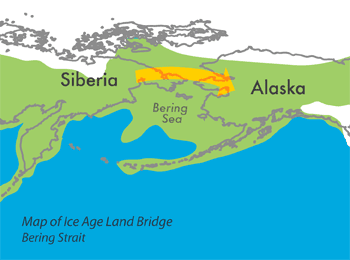 People who study the spread of humans to the Americas can agree on one thing — the first migrants crossed from Asia by way of a land bridge connecting Siberia and Alaska.
People who study the spread of humans to the Americas can agree on one thing — the first migrants crossed from Asia by way of a land bridge connecting Siberia and Alaska.
Just about everything else is subject to debate: who the people were, where they originated, when they migrated, how numerous they were and what they did once they crossed into the Americas.
Finally, a solution to the decades-old dispute may be at hand. That’s because genetic analyses are beginning to converge on a scenario that fits in with all the archaeological, linguistic, climatological and ecological data relevant to the issue — and also seems to make sense.
Rapid Migration
In this month’s issue of the American Journal of Human Genetics, researchers from Brazil and California argue that the present-day pattern of genetic diversity among Native Americans suggests a rapid southward migration along the Pacific coast that began about 18,000 years ago and took only a few thousand years to reach the tip of South America.
It was only later, the researchers claim, that people made their way inland in pursuit of large game animals such as woolly mammoth. The traditional view is that these mammoth hunters, who appear in the archaeological record about 13,000 years ago, were the first Americans.
This is not the first time a migration down the Pacific coast has been proposed. But the researchers were able to show by comparing the mitochondrial DNA of 86 Native Americans that all five of the major genetic branches in the New World trace back to an ancestral population of a few thousand people that began expanding rapidly around 18,000 years ago.
Coastal Route
At that time — not long after the peak of the Ice Age — glaciers thousands of feet thick blocked the land route from Alaska into the heart of North America. But the coast was clear. Recent research indicates the Pacific rim of North America was relatively ice-free by about 19,000 years ago.
The DNA evidence also offers information about the ancestral Asian populations that gave rise to the first Americans. The researchers compared the Native American DNA samples to their closest known relatives in Asia. It also found that the Asian and American lines appear to have split about 5,000 years before the rapid population expansion on the American side.
That suggests a long period of isolation. This was probably in the region that is now around (and underneath) the Bering Strait, before the first people flooded into the New World.
Native American Diversity
Two recent papers in the open-access journal Public Library of Science One suggest a similar scenario, albeit with slightly different dates. One study, published last month by University of Florida researchers, analyzed mitochondrial DNA donated by 77 Native Americans. That study found that the overall pattern of diversity was most consistent with a population that has experienced two episodes of rapid growth. The first was about 40,000 years ago, and period of growth happened about 15,000 years ago.
A second study, published last year by a global team of researchers, found that all of the major genetic branches of Native Americans appear to have started diversifying about 14,000 years ago. This was after being isolated for a long period of time.
The beauty of these genetic studies is their ability to explain the vexing archaeological evidence for the migration of people into the Americas. There are signs of humans living in Siberia, far from the major population centers of the time, as early as 30,000 years ago. And there is evidence of people at the Monte Verde archaeological site in southern Chile as early as 14,500 years ago.
Yet there are no archaeological sites intermediate between those two very distant locations in time and space. The genetic evidence suggest two reasons why. First, a small number of people migrating very quickly down the Pacific coast wouldn’t have left many artifacts behind. And second, if the migration happened shortly after the peak of the Ice Age, as the genetic evidence suggests, then the coastline it followed is now well offshore. Sea level has risen 120 feet since then.



